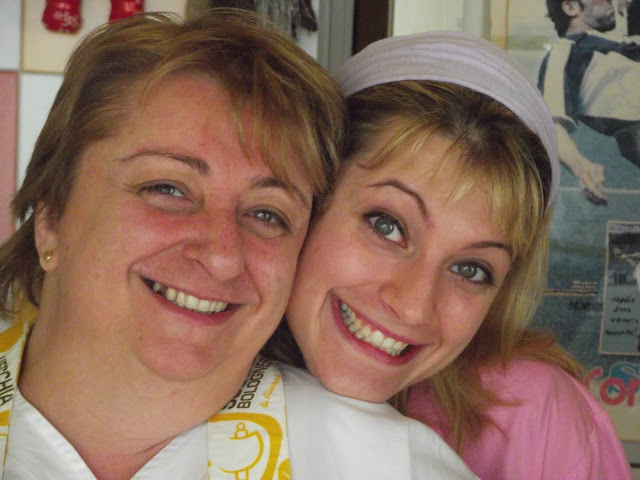 |
| Alessandra Spisne and her daughter Stefania |
A morning in La Vecchia Scuola, Alessandra Spisne’s celebrated cookery school (writes Liz). There we met Tim and Janet, two Canadians from Toronto with a passion for pasta. That’s why they are spending five days of their holiday learning how to make pasta.
 |
| Breaking the eggs into the flour 'nest' |
After donning the school’s t-shirt and yellow cap, they do what they do every day here: they create a 500g nest of flour and break five eggs into it. No olive oil, no semolina (‘that’s not traditional Bolognese’), no extra yolks, just flour and eggs.
Breaking the eggs with a fork, they gradually work in the flour until they have a ball of dough.
Breaking the eggs with a fork, they gradually work in the flour until they have a ball of dough.
 |
| Looking for San Luca |
Even though they are only here for a short time, they are taught to professional standards and learn how a real Bolognese kitchen works, with its separate spaces for the pasta maker and the sauce makers. In fact, many restaurants have a pasta workshop in another building where the sfoglina – the pasta maker – toils alone making tagliatelle and gramigna (a kind of curly macaroni that accompanies a sausage sauce), as well as the filled pastas.
The next step for Tim and Jackie is to knead the dough they have made. For this you need clean dry hands and just a little flour on the rolling board – just how much you need to knead depends on the season and the humidity. Today is hot and clammy, tough conditions for apprentice pasta makers.
Their task is to make tortellone, pasta filled (in this case) with a mixture of potato, parmesan and finely chopped parsley. Luckily you don’t have to roll the pasta as thin for tortellone as you do for the smaller, finer meat filled tortellini or for tagliatelle.
 |
| Kneading the dough |
As the students cut the sfoglio into small squares, they are told not to waste any of the pasta. ‘You’ve worked hard to make it’, says their teacher Simone, ‘so you want to use every scrap of it’. They work the off cuts into the squares, which makes the pasta thicker but for tortellone this is less critical. Another clever tip is about preparing the potatoes for the filling: they put them once cold through a ricer, skins and all, and what comes out is just the potato. To this they add parmesan, parsley and an egg, and then mix well before putting the stuffing into a piping bag.
 |
| End result |

No comments:
Post a Comment